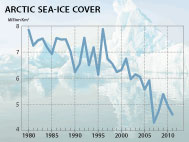| SEARCH |
-

Nov 17, 2015
Reflections on a three-decade legacy
The International Geosphere-Biosphere Programme (IGBP) will come to a close at t...
-
Nov 17, 2015
Use of and access to content on this website
Text and images produced by IGBP in house are free to use with appropriate credi...
-
Nov 12, 2015
Bella Gaia performance and panel discussion to mark IGBP's closure
A musical performance by Bella Gaia will celebrate the achievements and legacy o...
-

Towards Future Earth:
evolution or revolution?
During its three decades of existence, the International Geosphere-Biosphere Pro...
-
A personal note on IGBP and the social sciences
Humans are an integral component of the Earth system as conceptualised by IGBP. João Morais recalls key milestones in IGBP’s engagement with the social sciences and offers some words of advice for Future Earth.
-
IGBP and Earth observation:
a co-evolution
The iconic images of Earth beamed back by the earliest spacecraft helped to galvanise interest in our planet’s environment. The subsequent evolution and development of satellites for Earth observation has been intricately linked with that of IGBP and other global-change research programmes, write Jack Kaye and Cat Downy .
-
Deltas at risk
Around 500 million people worldwide live on deltas, but many of the world's deltas are sinking due ...
-
Climate change: the state of the science
A new data visualization released on the first day of the plenary negotiations at the UNFCCC’s clima...
-
Climate Change:
the State of the Science
Videos now online from the Stockholm public forum to mark the launch of the IPCC's climate report, 2...

Solve economic and environmental crises at the same time
Climate change, water and food scarcity, energy security and dangerous pollution are among urgent and accelerating problems across all aspects of the Earth system, the summit of high profile experts from 22 countries confirmed. Convened by the International Geosphere-Biosphere Programme (IGBP) and the Earth System Science Partnership (ESSP), summit participants noted the alarming fact that global carbon emissions have been increasing faster than any of the IPCC's scenarios from just 5 years ago, according to recent measurements.
“The consequences of the financial breakdown threaten the economic system. The consequences of the breakdown of the ecological system will be far worse in just a slightly longer time frame. Now as you're going to fix a short-term problem, take the opportunity to fix these long-term problems,” said Prof. Thomas B Johansson, a Lund University energy expert who is also Co-Chair of the Global Energy Assessment.
New economic agreements can and should heed natural limits and put the global recovery on a less carbon and resource intensive pathway. Recent economic trends were on course to raise global temperature by 4 to 6 degrees by the year 2100, levels considered catastrophic, according to IPCC projections.
Greener societies would lower risks while providing better quality of life, eliminating poverty and enhancing social coherence. In contrast, using the conventional measure of GDP growth as the lead indicator of national policies “has been badly misleading us,” Prof. Robert Costanza, an ecological economist at the University of Vermont, noted here.
New policies must tackle problems using an integrated Earth systems approach, including all human-environment interactions. Dr. Jill Jäger, senior researcher at the Sustainable Europe Research Institute, explained that what is missing are flexible processes that allow both multi-part dialogue and higher rates of learning to link expert knowledge to action effectively.
"The situation requires urgent action, the equivalent of war-time mobilisation. We need to drive solutions together, through best policies from governments, best practices from industry, and best behaviours from consumers," commented Mr. Anthony Simon, a former senior Unilever executive now active in networks including the World Business Council for Sustainable Development.
The summit, an activity of IGBP’s “The Planet in 2050” research initiative, tasked 4 working groups on energy technology, land-use, culture-development-economy, and interchanges with the Earth system, to define desirable visions of the planet in 2050 and identify pathways, obstacles and opportunities. It will soon publish a public report. “A plan for a sustainable planet is doable,” Prof. Guy Brasseur of the US National Center for Atmospheric Research and one of the meeting's initiators, said. “It requires immediate measures. Long term, it will require different education systems that are conceived around the need to reconcile human beings with the rest of nature.”
Meeting participants available for interviews:
Dr. Johan Rockström (SRC) +46 8 674 7200
Dr. Thomas B Johansson (Lund Univ/IIIEE) +46 73 225 700
Dr. Robert Costanza (UVT/Gund Institute) +1 802 922 6065
Dr. Jill Jäger (SERI) +43 676 301 50 95
Mr. Anthony Simon +32 478 217 063
Dr. Guy Brasseur (NCAR) +1 303 718 3697
Press contacts:
Ms. Elisabeth Knöppel (IIIEE) +46 705 77 22 02; Mr. Torvald Jacobsson (IIIEE) +46 70 52 36 547; Ms. Mary Ann Williams (IGBP) +46 8 673 9562.
Website: http://www.theplanet2050.org
Background Information
The overall objective of The Planet in 2050 is to analyse and describe what the Earth might be like in 2050 based on expert knowledge from a wide range of disciplines. The intent is to complement the well-known IPCC, Millennium Assessment, etc., by focusing on a range of specific aspects of the Earth System and describing their future trajectories individually. The idea is to use a wide range of views of experts to explore ways that different assumptions and world views colour the way we envisage the future.

IGBP closed at the end of 2015. This website is no longer updated.
-

Global Change Magazine No. 84
This final issue of the magazine takes stock of IGBP’s scientific and institutional accomplishments as well as its contributions to policy and capacity building. It features interviews of several past...
-

Global Change Magazine No. 83
This issue features a special section on carbon. You can read about peak greenhouse-gas emissions in China, the mitigation of black carbon emissions and the effect of the 2010-2011 La Niña event on gl...
-
INTERGOVERNMENTAL PANEL ON CLIMATE CHANGE:
How green is my future?
UN panel foresees big growth in renewable energy, but policies will dictate just how big.
-
UK:
'The Anthropocene: a new epoch of geological time?'
Royal Society, Philosphical Transactions A




















